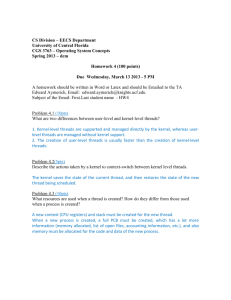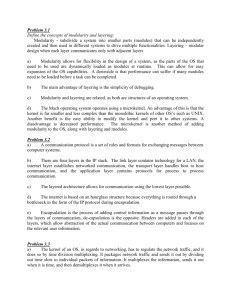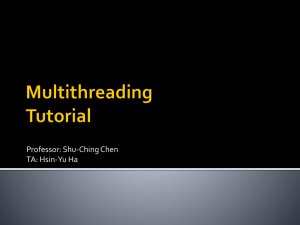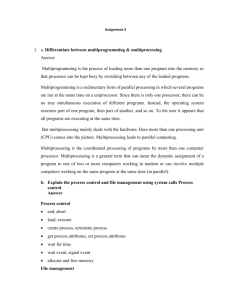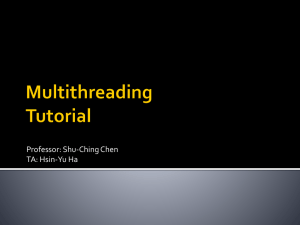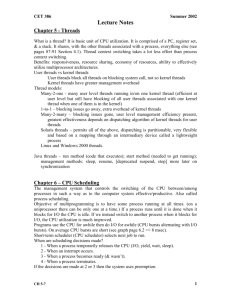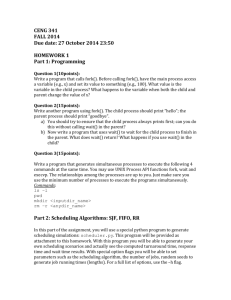COM5231 ****** *** (11/3/2000, 9:00
advertisement
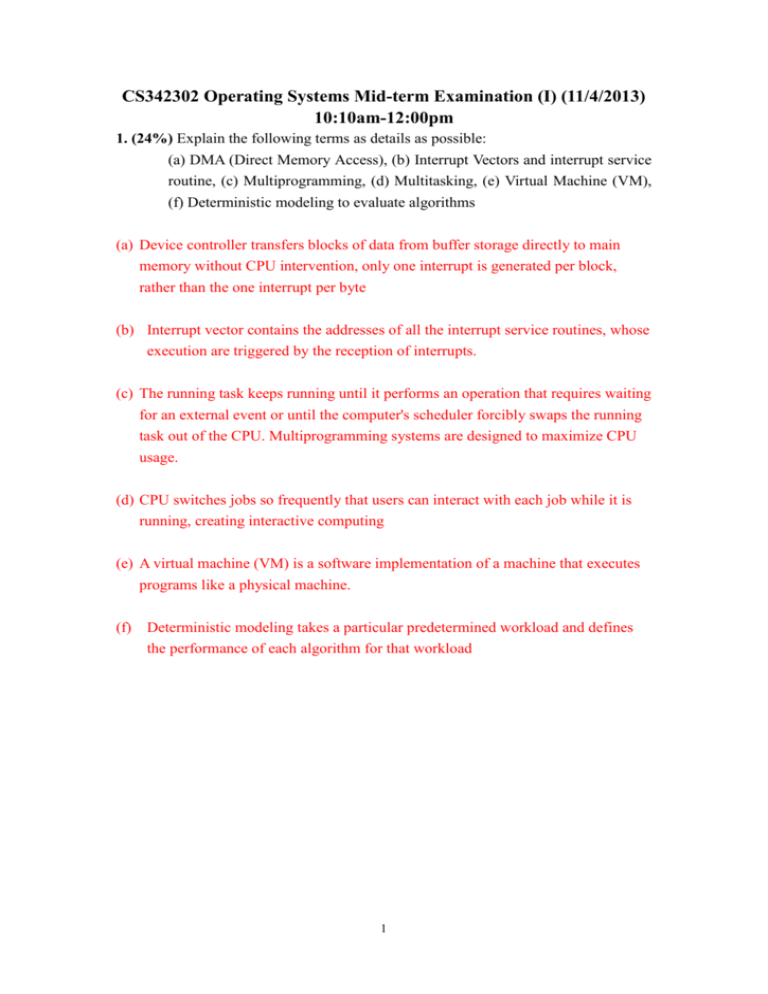
CS342302 Operating Systems Mid-term Examination (I) (11/4/2013)
10:10am-12:00pm
1. (24%) Explain the following terms as details as possible:
(a) DMA (Direct Memory Access), (b) Interrupt Vectors and interrupt service
routine, (c) Multiprogramming, (d) Multitasking, (e) Virtual Machine (VM),
(f) Deterministic modeling to evaluate algorithms
(a) Device controller transfers blocks of data from buffer storage directly to main
memory without CPU intervention, only one interrupt is generated per block,
rather than the one interrupt per byte
(b) Interrupt vector contains the addresses of all the interrupt service routines, whose
execution are triggered by the reception of interrupts.
(c) The running task keeps running until it performs an operation that requires waiting
for an external event or until the computer's scheduler forcibly swaps the running
task out of the CPU. Multiprogramming systems are designed to maximize CPU
usage.
(d) CPU switches jobs so frequently that users can interact with each job while it is
running, creating interactive computing
(e) A virtual machine (VM) is a software implementation of a machine that executes
programs like a physical machine.
(f)
Deterministic modeling takes a particular predetermined workload and defines
the performance of each algorithm for that workload
1
2.(6%) Explain the following queueing-diagram representation of process scheduling.
Where are the long-term, mid-term, and short-term scheduling algorithms in
this diagram? What are their function goals ?
(1) 0.5 point each
Mid-term
Long-term
Short-term
(2) 1.5 points each
Short-term scheduler: Selects from among the process that are ready to
execute and allocate CPU to it.
Mid-term scheduler: Swap out some process out of memory to solve memory
space problem or reduce the degree of multiprogramming.
When there’s enough memory space, processes will be swap-in and
start from where it left.
Swap out: 0.5 point
Swap in: 0.5 point
Solve memory space problem…. : 0.5 point
Long-term scheduler: Select processes from pool and loads them into
memory for execution.
3.(5%) Using the following program. Explain what the output will be at Line A.
# include <sys/types.h>
# include <stdio.h>
# include <unistd.h>
int value = 5;
int main ()
{
Pid_t pid;
pid = fork();
if (pid ==0) { /* child process */
value += 20;
return 0;
}
else if (pid > 0) { /* parent process */
wait(NULL);
2
printf(“PARENT: value = %d”, value); /* LINE A */
return 0;
}
}
LINE A will print PARENT: value =5. (3 points)
fork() copy the entire code to create a new as child process.
(1 point)
Parent and child process have their own memory, the child process simply
continues to execute exactly the same program that the parent process was
running.(1 point)
每個解釋不完整扣 0.5 分
4.(10%) What is a “thread” and what is the “context” of a thread ? What are the
differences among user-level threads, kernel-level threads, and processes ?
Thread (2) –the smallest sequence of programmed instructions that can be
managed independently by an operating system scheduler
Context of a thread (2) –minimal set of data used by this task that must be
saved to allow a task interruption at a given date, and a continuation of this
task at the point it has been interrupted and at an arbitrary future date
User-thread (2) – scheduled and created by user-thread library, need kernel
thread’s help if it want to execute system call. Kernel don’t know the
existence of user thread .
Kernel-thread (2) – scheduled and created by Operating system, can execute
system call. There must be a mapping between user thread and kernel thread.
Processes (2) - an instance of a computer program or application that is being
executed. It contains the program code and its current activity
答案不完整扣 1 分,扣至該部分分數為零
5.(10%) Explain the “one-to-one model” and “many-to-many model” to establish the
relationship between user threads and kernel threads. How user-level threads
are scheduled by the Thread Library with the Light Weight Processes (LWP) ?
How kernel threads are scheduled by the OS ? and how OS communicates
with a process to inform the number of allocated LWPs ?
One-to-one model (2) : Creating a user thread requires creating the
corresponding kernel thread
Many-to-many model (2) : Multiplexes many user level threads to a
small or equal number of kernel threads
3
(2) Each LWP is attached to a kernel thread and it is kernel threads that
the operating system schedules to run on physical processor
(2) Kernel threads are scheduled by the OS -> 提到任何部分,描述合
理即給分。
(2) Kernel makes an upcall to the application informing block which
can then be used to know the number of allocated LWPs. -> 提到
Upcall 即給分
6.(10%) The following program uses the Pthreads APIs. What would be the output
from the program at LINE C and LINE P ?
# include <pthread.h>
# include <stdio.h>
int value = 0;
void *runner(void *param); /*the thread */
int main (int argc, char *argv[])
{
int pid;
pthread_t tid;
pthread_attr_t attr;
pid = fork();
if (pid ==0) { /* child process */
pthread_attr_init(&attr);
pthread_create(&tid,&attr, runner, NULL);
pthread_join (tid, NULL);
printf (“CHILD: value = %d”, value); /* LINEC*/
}
else if (pid > 0) { /* parent process */
wait(NULL);
printf(“PARENT: value = %d”, value); /* LINE P */
}
}
void *runner (void *param) {
value = 10;
pthread_exit(0);
}
The parent forks a child process which has its own memory space, then waits
for the forked child process to complete. The child process creates a new
thread with the same memory space as the child process, and changes the
value of the global variable to 10. Then it outputs the value of that variable
4
which is 10 and the child process finishes.
In the parent process, the value
of the global variable remains unchanged and its value is outputted, which is
0.
答案 2 分,解釋 3 分
解釋不完全扣 1 至 2 分,錯誤解釋不給分
7.(10%) The traditional UNIX scheduler enforces an inverse relationship between
priority numbers and priorities: the higher the number, the lower the priority.
The scheduler recalculates process priorities once per second using the
following function:
Priority = (recent CPU usage /2) + base
Where base = 60 and recent CPU usage refers to a value indicating how
often a process has used the CPU since priorities were last recalculated.
Assume that recent CPU usage for process P1 is 40, for process P2 is 18,
and for process P3 is 10. What will be the new priorities for these three
processes when priorities are recalculated ? Based on this information, does
the traditional UNIX scheduler raise or lower the relative priority of a
CPU-bound process ?
(1) The new priorities are recalculated below:
P1: (40/2)+60=80
P2: (18/2)+60=69
P3: (10/2)+60=65
(6 points in total, 3 points for formula, 3 points for answer)
(2) The traditional UNIX scheduler lower the relative priority of a
CPU-bound process.
(4 points)
8.(15%) Consider the following set of processes, with the length of the CPU burst
given in milliseconds.
Process
Burst time
Priority
P1
12
3
P2
1
1
P3
2
3
P4
1
4
P5
6
2
The processes are assumed to have arrived in the order P1, P2, P3, P4, P5, all
at time 0.
(a) (4%) Draw four Gantt charts that illustrate the execution of these
processes using the following scheduling algorithms: FCFS, SJF,
nonpreemptive priority (a smaller priority number implies a higher
5
priority), and RR (quantum =2)
(b) (4%) What is the turnaround time of each process for each of the
scheduling algorithms in part (a)
(c) (4%) What is the waiting time of each of these scheduling algorithms ?
(d) (3%) Which of the algorithms results in the minimum average waiting
time (over all processes) ?
FCFS:
P1
0
P2
12
SJF:
P2
P3
13
P4
15
P4
P3
P5
16
P5
22
P1
0
1
2
4
10
22
Non-preemptive:
P2
P5
P1
P3
P4
0
1
7
19
21
22
RR:
P1
P2
P3
P4
P5
P1
P5
P1
P5
P1
P1
P1
0
2
3
5
6
8
10
12
14
16
18 20 22
Turnaround Time:
FCFS -> P1: 12, P2: 13, P3: 15, P4: 16, P5: 22
SJF -> P1: 22, P2: 1, P3: 4, P4: 2, P5: 10
Non-preemptive priority -> P1: 19, P2: 1, P3: 21, P4: 22, P5: 7
RR -> P1: 22, P2: 3, P3: 5, P4: 6, P5: 16
Waiting Time:
FCFS -> P1: 0, P2: 12, P3: 13, P4: 15, P5: 16
SJF -> P1: 10, P2: 0, P3: 2, P4: 1, P5: 4
Non-preemptive priority -> P1: 7, P2: 0, P3: 19, P4: 21, P5: 1
RR -> P1: 10, P2: 2, P3: 3, P4: 5, P5: 10
Minimum average waiting time:
SJF
Gantt Chart 每項目 1 分,小錯誤扣 0.5 分
Turnaround time / waiting time 每項目 0.2 分
題目規定 for each process of each algorithm 需標出 turnaround
time,若未標出各 Process 為多少,不給分
6
9.(10%) Suppose that the following processes arrive for execution at the times
indicated. Each process will run for the amount of time listed. In answering
the questions, use nonpreemptive scheduling, and base all decisions on the
information you have at the time the decision must be made.
Process
P1
P2
P3
Arrival time
0.0
0.4
1.0
Burst time
8
4
1
(a) (3%)What is the average turnaround time for these processes with the
FCFS scheduling algorithm ?
(b) (3%) What is the average turnaround time for these processes with the
SJF scheduling algorithm ?
(c) (4%) The SJF algorithm is supposed to improve performance, but notice
that we chose to run process P1at time 0 because we did not know that
two shorter processes would arrive soon. Compute what the average
turnaround time will be if the CPU is left idle for the first 1 unit and then
SJF scheduling is used. Remember that processes P1 and P2 are waiting
during this idle time, so their average waiting time may increase.
(a)
FCFS:
P1
0
P1: 8-0 = 8
P2: 12-0.4 = 11.6
P3: 13-1 = 2
Avg: 10.53
P2
P3
8
12
13
(b)
SJF:
P1
0
P1: 8 - 0 = 8
P2: 13 - 0.4 = 12.6
P3: 9 - 1 = 8
Avg: 9.53
P2
P3
8
9
(c)
7
13
Idle
0
1
P1: 14 - 0 = 14
P2: 6 - 0.4 = 5.6
P3: 2 - 1 = 1
Avg: 6.87
P3
P2
P1
2
6
14
(a) (b) 答案對且附計算過程即給全部分數,若平均為錯,分項目給分,
每項目一分
(c) 項目、平均都各一分
8
